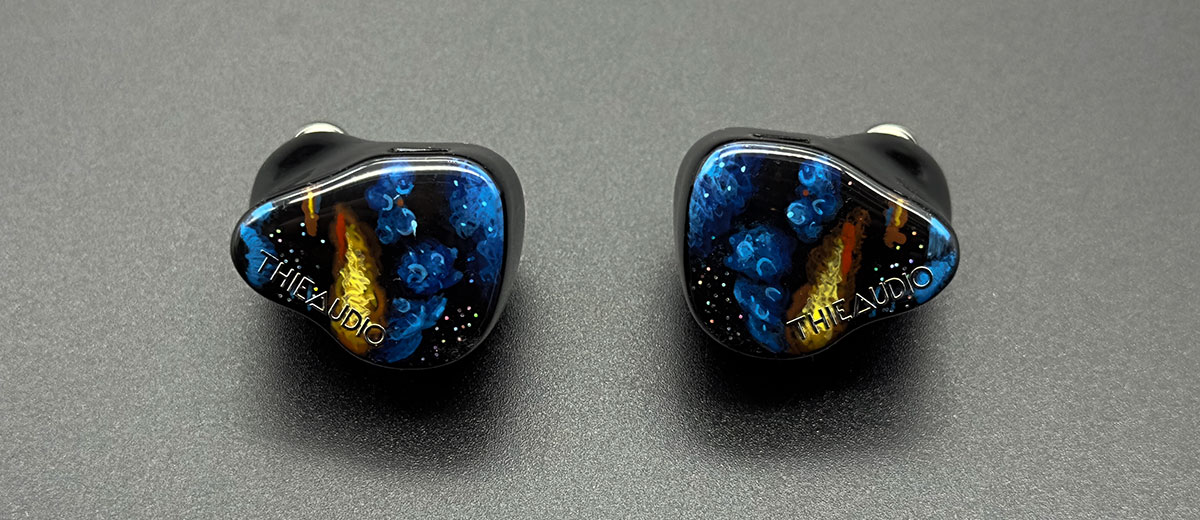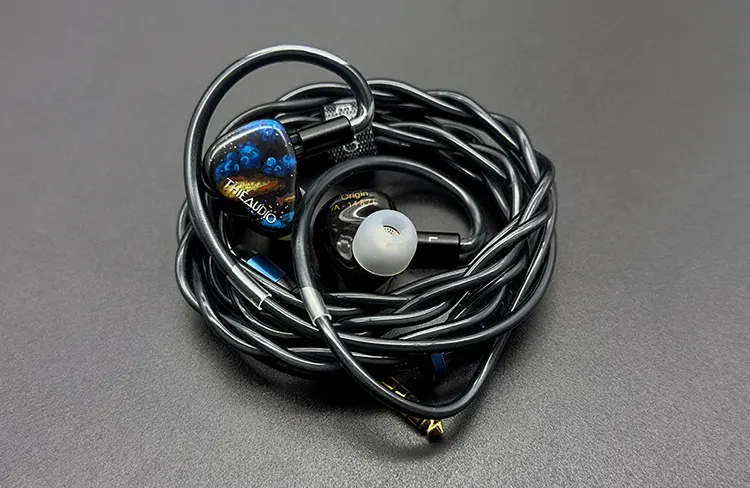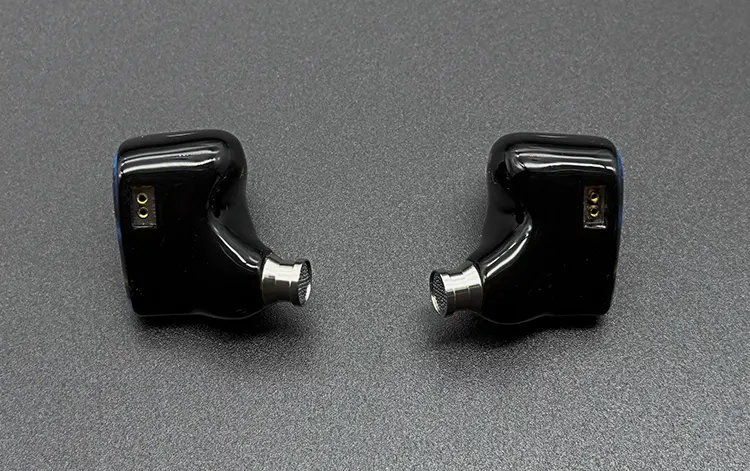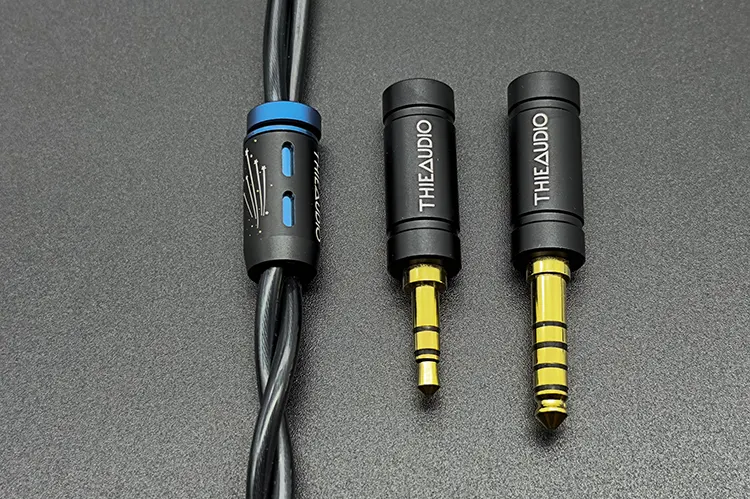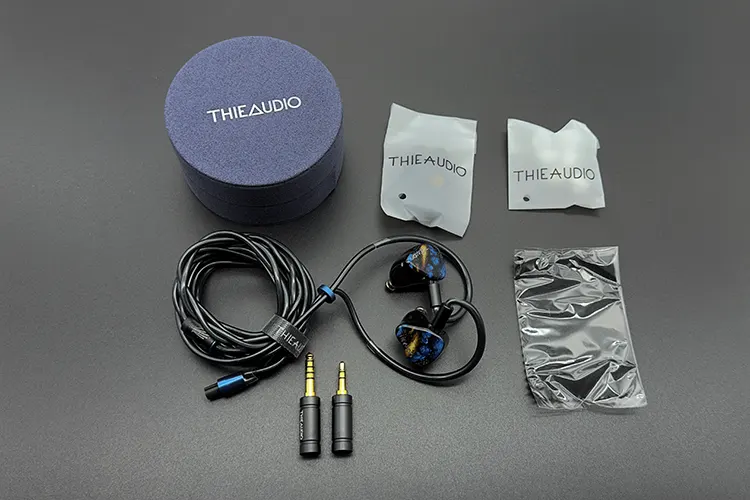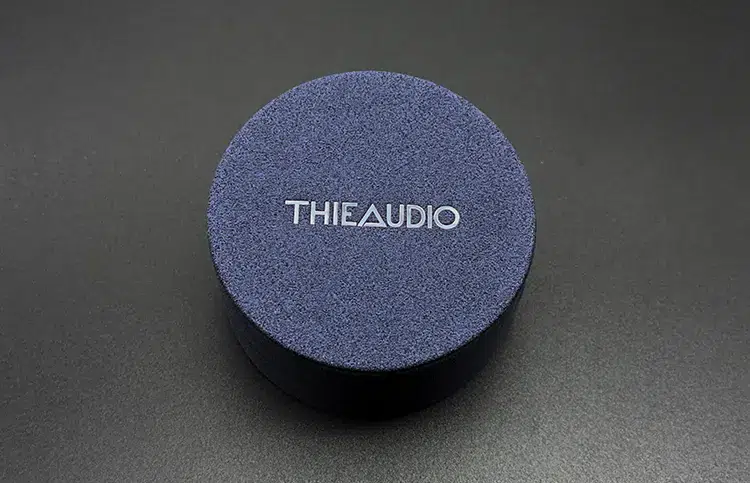Nihal reviews the THIEAUDIO Origin, a new high-end 10mm dynamic, BA, EST, and bone conduction driver universal IEM in today’s feature. It is priced at $849.
Disclaimer: This is a sample in exchange for my honest opinion. Headfonics is an independent website with no affiliate links or status. I thank Linsoul and THIEAUDIO for this opportunity.
Click here to read more about THIEAUDIO products previously reviewed on Headfonics.
This article follows our latest scoring guidelines which you can read in more detail here.
Reviewing the THIEAUDIO IEMs this year was fun. After reviewing the Hype 4, Oracle MKIII, and Hype 10, I have a deep respect for the brand.
If you ever speak with me, you will find that I am a bit of a THIEAUDIO enthusiast. Adapting to budget, mid, and premium segments, they have been evolving release after release. The value their IEMs provide has been rather constant.
Origin turned out to be THIEAUDIO’s last release of 2024, so I had been eager to hear it. The drive arrangement, with a bone conduction driver, makes it intriguing.
In this review, I will explore Origin’s performance in depth and compare it to other IEMs in its price range including the Yanyin Carmen and the Moritz Audio Paradise.
Features
THIEAUDIO Origin features a quad-brid driver configuration with a total of 8 drivers per side.
The drivers include an in-house 10mm bio-cellulose diaphragm dynamic driver, four balanced armatures drivers with a mix of Sonion and Knowles, and dual Sonion electrostatic super tweeters. In addition to these, there is also an in-house developed 11mm bone-conductor driver present.
The dynamic driver handles the lower frequency range. The low-mids and the midrange are taken care of by the Sonion BA driver, while the Knowles BA drivers help in delivering upper and lower treble frequencies.
The two EST drivers take care of the ultra-treble frequencies. The BC driver has been tuned to complement the midrange and treble frequencies, which add tactile vibrations for an enhanced experience. I could not find details on the crossover system.
Design
THIEAUDIO maintains consistency in design across its IEMs. Origin is no exception, with a design language we have seen on Hype series IEMs.
Origin shells are built in European medical-grade resin. They have a sleek, all-black look with a vibrant, colorful yet subtle-looking faceplate.
The faceplate has an abstract design showcasing a mix of blue and yellow color patterns. There are tiny colorful sparkles scattered on the faceplate, which add a subtle shine when facing light. The brand’s logo is neatly placed along the edge of the faceplate on both shells.
The IEM connects via a recessed 2-pin 0.78mm socket. The nozzle is metallic and is shorter and wider than the usual ones you might encounter.
Additionally, there’s a small vent near the nozzle, protected by a mesh filter—a design element consistent across many THIEAUDIO IEMs. Overall, all the design elements are quite similar to their recent releases.
Comfort & Isolation
The Origin’s shells are massive. The shells have an ergonomic design, but the size can pose a challenge to the users.
For me, the size did not bother me much, to be honest, but I can see it can be challenging, especially for those who have smaller earlobes, as it pushes a lot due to its size. To give you an idea of their relative sizes, the Origin shells are as big as those of Hype 10’s.
The shells are lightweight and have smooth curves, adding to the comfort factor. There are no sharp edges on the shells to cause discomfort during longer listening sessions.
I found the fit to be very snug but without the IEMs sticking out of my ears. Once put in, they stay comfortably secure. Even on the move, I do not feel any loosening or a feeling of falling out.
The isolation factor is decent, blocking a fair amount of outside noise. If you are surrounded by a few people chit-chatting at normal volumes, it can easily block such noises. In my time with the Origin, I did not feel any pressure build-up either.
Ear Tips
The THIEAUDIO Origin comes with a set of foam and silicone tips. I have been complaining about the inclusion of ear tips because the same set of ear tips has been on every THIEAUDIO IEM I have reviewed. It would be a relief to see a variety.
The silicone tips are available in small, medium, and large, as are the foam tips. The foamies have colorful stems for easy identification.
I do not get a satisfactory fit with the silicone ear tips. I had to experiment with aftermarket ear tips a bit to find a decent fit, and ultimately, the SpinFit Omni ear tips provided the best fit and performance. The Nostalgia Audio XWB ear tips also provide a decent fit.
Stock Cable
Thankfully, the Origin comes with a different cable than I had seen on the last few THIEAUDIO IEMs. This cable has an entirely different build and design.
It features high-grade components, including silver-plated 5N linear crystal oxygen-free copper (LCOFC) wire and silver-plated 4N LCOFC wire—a total of 161 wires in a 20AWG configuration.
Additionally, the cable incorporates spiral shielding and Litz Type 2 technology for enhanced durability and reduced signal loss.
The outer layer of dark grey-colored PVC gives the cable a pleasing premium touch. However, this adds a bit of stiffness. It strikes me as a softer and thinner version of Effect Audio Code cables. The adapter, Y-split, and slider have a mix of blue and black colors, giving the cable a very refreshing look.
The cable features THIEAUDIO’s modular connector system, which allows users to swap the cable plug between 3.5mm unbalanced, 4.4mm balanced, and 2.5mm balanced connectors. The cable performs decently, so I never felt the need to swap it out for something else.
Packaging & Accessories
Similar to the other THIEAUDIO IEMs as Hype 10 and Oracle MKIII, the Origin arrives in a large box. The outer sleeve has an image of the IEMs, having a black background as the faceplates and information about the driver configuration and some other features of the model.
The rear side has a lot of information on the company. When you open the sleeve, you get the black box with the THIEAUDIO engraved in silver.
When you open the box, the IEMs are neatly presented. On one side, the cable is carefully rolled up and placed in a dedicated cutout, while on the other side, the carry case is securely held within a large cutout.
The foam inside the box is firm enough to keep the IEMs and accessories safe. Inside the carry case, you’ll find two packs of ear tips and a cleaning cloth. I was relieved to find a different arrangement from the earlier released IEMs.
The accessories with the Origin include:
- Carry Case
- Foam Tips + Silicone Ear Tips
- Silver-plated OCC Cable with multiple adapters
- Cleaning cloth
- Pair of IEMs
Carry Case
With the Origin, you don’t get the usual black zippered case. Instead, it comes with a round earphone case crafted by hand using eco-friendly Alcantara suede material.
The case has a soft, elegant feel, and I find it much better than the earlier black cases. It offers ample space inside and has a soft lining to ensure the IEMs remain well-protected over time.
The puck-style case opens by sliding the top, which remains firmly attached when closed, so it won’t open easily. The round design makes the case simple to carry, catering to on-the-go needs.
Sound Impressions
The following sound impressions of the THIEAUDIO Origin were completed using a mixture of my main source, Lotoo’s Paw Gold Touch, and the Questyle CMA18P. For the review, I paired the IEMs with stock cable and SpinFit Omni ear tips, size L.
Summary
Origin has a very easily recognizable THIEAUDIO in-house sound. Coming from IEMs like Oracle MKIII and Hype 10, you can easily relate to the Origin’s tuning. It remains rather balanced throughout the frequency range but with an elevated bass response.
The bass is quite strong, with some emphasis on the sub-bass while maintaining a good impact and tightness in the mid-bass region. The midrange, like most sibling IEMs, stays near neutral with a touch of musicality and sweetness.
The two EST drivers make the treble region pleasant without any harshness or sibilance. The bone conduction driver adds vibrancy to the sound, adding a layer of excitement. With the Origin, you can observe the BCD in action due to the tactile vibrations.
Bass
The bass on Origin is quite special and is something that grabs your attention as soon as you put the IEM in your ears. The bass is full-bodied and with a big-bold impact. The bass has a slight warmth in it and does not feel dry. It has a nice speed with a satisfying decay.
There is a decent balance of mid-bass and sub-bass while not putting a focus on one over the other. The sub-bass region offers nice rumbles and adequate depth. There’s just pleasing tightness in the mid-bass as well, with excellent impact.
I have seen a few people complaining about losing bass on some earlier THIEAUDIO IEMs, which felt thick and not so tight. That’s not the case with the Origin. The bass stays sharp and defined even at higher volumes or in rather complex audio tracks. Origin’s bass should easily please the bassheads.
The other features, such as texture and layering, are well taken care of by Origin. On a bass-heavy track, you can hear the bass produced by different sources.
One other noticeable thing is that this bass does not bleed into the higher frequencies. While in some IEMs, excess bass would sometimes mask the nuances, the Origin’s bass sounds crisp and controlled.
Midrange
The midrange does not deviate much from other THIEAUDIO offerings. THIEAUDIO puts effort into keeping the mids near neutral, which they have done on the Origin as well.
There is a slight touch of warmth to keep things engaging. The lower midrange benefits from the bass shelf, exhibiting a satisfying sense of body and weight, helping achieve a lushness and pleasing depth.
The midrange is neither recessed nor very forward. The vocals take prominence, with midrange instruments nicely arranged around them.
The male vocals benefit from the lower midrange, which imparts adequate density and body to them, while the female vocals shine as well, thanks to the warmth and energy in the upper midrange. I really like the sweetness and naturalness of the female vocals on Origin.
The upper midrange is very well extended, with enough details to give a sense of openness. The best part is the seamless transition from the lower midrange to the upper midrange.
Treble
With two Knowles drivers and two EST drivers, the Origin has a very refined treble range. I find the treble very smooth with no sharp peaks. It is quite detailed, well-extended, and has plenty of sparkles.
There is plenty of energy, however, I find it a bit restricted to avoid overemphasis or sharpness. On no occasion, I found the treble to be fatiguing.
The notes are very well defined with a natural, smooth decay. Origin delivers crisp highs in a manner that feels natural and simple on the ears.
The notes are distinct, with minimal overlap, ensuring there is clarity and separation. Instruments such as cymbals and hi-hats exhibit impressive energy, while violins and flutes are rendered with finesse, offering smooth, airy highs.
Staging & Dynamics
The Origin’s technical capability is more than impressive. The soundstage it offers is massive, very wide, and has excellent depth.
The holographic stage presentation on the Origin is special, enhancing the sense of space and separation. This also helps the instruments spread far and wide across the stage.
One does not encounter such a presentation very often. It is mostly attributed to the inclusion of the BCD, which adds a layer of expansiveness to the soundstage.
The imaging capability is solid, with instrument positioning being quite precise. The layering and instrument separation benefit as well, as I did not sense any congestion even with complex tracks.
The resolution on the Origin is handled quite well, bringing out the fine details and nuances very accurately.
Click on page 2 below for my recommended pairings and selected comparisons.

